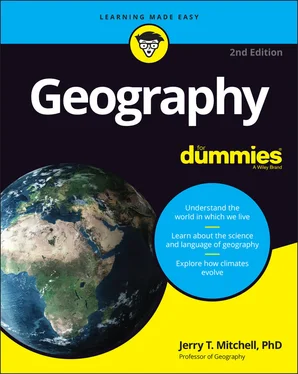Jerry T. Mitchell - Geography For Dummies
Здесь есть возможность читать онлайн «Jerry T. Mitchell - Geography For Dummies» — ознакомительный отрывок электронной книги совершенно бесплатно, а после прочтения отрывка купить полную версию. В некоторых случаях можно слушать аудио, скачать через торрент в формате fb2 и присутствует краткое содержание. Жанр: unrecognised, на английском языке. Описание произведения, (предисловие) а так же отзывы посетителей доступны на портале библиотеки ЛибКат.
- Название:Geography For Dummies
- Автор:
- Жанр:
- Год:неизвестен
- ISBN:нет данных
- Рейтинг книги:5 / 5. Голосов: 1
-
Избранное:Добавить в избранное
- Отзывы:
-
Ваша оценка:
- 100
- 1
- 2
- 3
- 4
- 5
Geography For Dummies: краткое содержание, описание и аннотация
Предлагаем к чтению аннотацию, описание, краткое содержание или предисловие (зависит от того, что написал сам автор книги «Geography For Dummies»). Если вы не нашли необходимую информацию о книге — напишите в комментариях, мы постараемся отыскать её.
Geography For Dummies
Geography For Dummies
Geography For Dummies — читать онлайн ознакомительный отрывок
Ниже представлен текст книги, разбитый по страницам. Система сохранения места последней прочитанной страницы, позволяет с удобством читать онлайн бесплатно книгу «Geography For Dummies», без необходимости каждый раз заново искать на чём Вы остановились. Поставьте закладку, и сможете в любой момент перейти на страницу, на которой закончили чтение.
Интервал:
Закладка:
Why things are the way they are: Physical systems
I bet you have a favorite time of year, a favorite season. You probably also have a least-favorite season. No doubt you can tell me why you like some seasons more than others, and you can probably sprinkle your rationale with personal anecdotes about good times and bad. If that sounds about right, then you are already familiar with physical systems.
Atmosphere, land, and water are the principal components of the physical world. Geography seeks to understand how these phenomena vary from one location to the next and why. Geographers aren’t content to know what the world looks like. They also want to know how it works. Why do islands like Aruba (near South America) and Socotra (off the Arabian peninsula), thousands of miles apart, have similar climates but differing land features? That involves understanding the natural processes that shape and modify Earth’s surface (see Chapters 6and 7), cause particular climates to occur in particular places (see Chapters 9and 10), or result in some parts of Earth having too little water and others too much (see Chapter 8).
Giving that human touch: Human systems
Have you ever visited a locale that has many more or many fewer people than where you live? Have you ever moved a long distance? Have you ever visited a foreign country? Have you ever noticed that most of your shoes and clothing are made in a foreign country? Have you ever attempted to talk to someone, only to discover that person does not speak your language? Have you ever tried a very different cuisine (such as polishing off a mopane worm in South Africa as I have done)? If so, then you are already familiar with human systems.
Human beings characterize Earth’s surface. That is, not only do humans live here, but by constructing cities, making farms, laying railways, and building other things, humans are an actual part of Earth’s surface. Culture, trade, commerce, and government largely determine the specific ways in which people are part of Earth. And because these institutions are so diverse, so, too, are the human characteristics that are part of Earth’s surface. Key aspects of human geography will be dealt with in separate chapters. They include population characteristics (see Chapter 11), movement and migration (see Chapter 12), cultural attributes (see Chapter 13), division of Earth into political units (see Chapter 14), economic activity (see Chapter 15), and urbanization (see Chapter 17).
Interacting with the world around us: Environment and society
Do you remember a farm or piece of countryside that is now a shopping center or a housing development? Have you ever experienced air pollution or water pollution? Have you ever had to cope with a severe storm, flood, or earthquake? If so, then you are already familiar with environment and society.
Human beings and the natural environment interact in many ways. For example, people play a very important role in shaping and modifying the natural world. Some results of this interaction may be visually pleasing, such as the skyline of Paris, or the terraced rice paddies of Southeast Asia, or the English countryside. But other results may be troubling, such as pollution and global deforestation, or the landscape devastation and human health problems stemming from Chinese uranium mining in Africa. References to human impact on the environment will appear in several chapters, particularly the ones dealing with water (see Chapter 8), natural resources (see Chapter 16), and urbanization (see Chapter 17). Most importantly, an entire chapter will be devoted to matters of environmental quality (see Chapter 18).
And while people impact the environment, environmental phenomena impact people. Climate affects agriculture and other human activity (see Chapters 9and 10). Landforms and related processes and hazards affect life and property — think how Hurricane Katrina in 2005 upended the entire Mississippi coastline (see Chapters 6and 7). The geography of water impacts settlement and commerce (see Chapter 8). In a nutshell, relationships between environment and society are pervasive, profound, and often political — and for those reasons will manifest themselves in several chapters.
Putting geography to use: Uses of geography
Have you ever used a mapping website to plan a trip? Have you ever visited a historical site and looked at maps and exhibits that help you understand the past? Have you ever attended a meeting or read an article concerning a proposal that would change the physical character of your neighborhood? If so, then you are already familiar with the uses of geography.
You can use geography to understand the past, interpret the present, or plan for the future. That is, you can use geography to understand the extent of former empires, to understand why your city looks the way it does, or to choose the location of a new factory. Geography is, therefore, a very useful and powerful tool.
Chapter 2
Thinking Like a Geographer
IN THIS CHAPTER
 Thinking geographically
Thinking geographically
 Taking a look at two case studies
Taking a look at two case studies
 Geography is as much a way of thinking about the world as it is a body of information and concepts. Therefore, if you want to become good at geography, you must learn to think geographically. Remember when you were in the third grade and the teacher said, “Let’s all put on our thinking caps”? Cute line, wasn’t it? Well, I’m asking you to put on your thinking cap — your geography thinking cap, that is.
Geography is as much a way of thinking about the world as it is a body of information and concepts. Therefore, if you want to become good at geography, you must learn to think geographically. Remember when you were in the third grade and the teacher said, “Let’s all put on our thinking caps”? Cute line, wasn’t it? Well, I’m asking you to put on your thinking cap — your geography thinking cap, that is.
Thinking geographically is a process that involves a discreet set of skills. Therefore, this chapter is very different from the rest because it’s not, on the whole or in part, about the content of geography. Certainly, you will encounter a fair amount of information about a particular part of the world. If you remembered it, great, but that’s not the point. Instead, the goal is for you to learn how to think geographically and see that doing so facilitates a deeper understanding of the human and natural phenomena that geographers study.
Changing the Way You Think — Geographically
In Chapter 1, the content of geography was likened to a pizza pie, and The Six Essential Elements were presented as a way to “cut it up.” The same National Geography Standards that give us those Elements also present a series of related skills that together constitute the process of thinking geographically. They include:
Asking Geographic Questions: Thinking geographically typically begins with the questions “Where?” and “Why?” Sticking with pizza, one might want to know where all of the pizza shops in town are located and why they are there. Conversely, a person going into the pizza business may want to know where a good location would be to open a new pizza shop, and why.
Acquiring Geographic Information: Geographic information is information about locations and their characteristics. If you want to know where all the local pizza shops are and why, then a first step may be to consult the internet (where you’ll probably even find a map!). You may also visit the sites and acquire information about their characteristics. Similarly, someone going into the pizza business may do the same thing in order to learn the locations and characteristics of the sites that competitors have previously chosen.
Читать дальшеИнтервал:
Закладка:
Похожие книги на «Geography For Dummies»
Представляем Вашему вниманию похожие книги на «Geography For Dummies» списком для выбора. Мы отобрали схожую по названию и смыслу литературу в надежде предоставить читателям больше вариантов отыскать новые, интересные, ещё непрочитанные произведения.
Обсуждение, отзывы о книге «Geography For Dummies» и просто собственные мнения читателей. Оставьте ваши комментарии, напишите, что Вы думаете о произведении, его смысле или главных героях. Укажите что конкретно понравилось, а что нет, и почему Вы так считаете.












